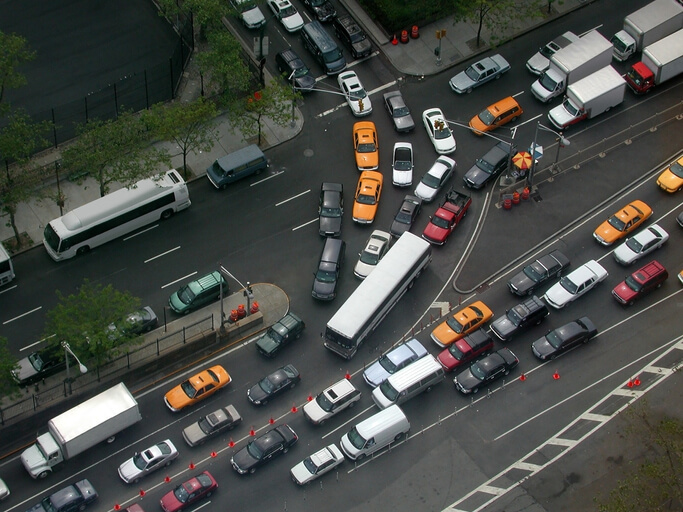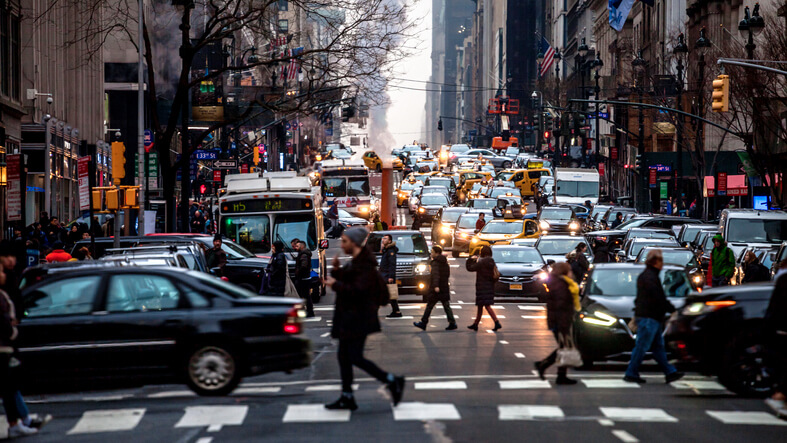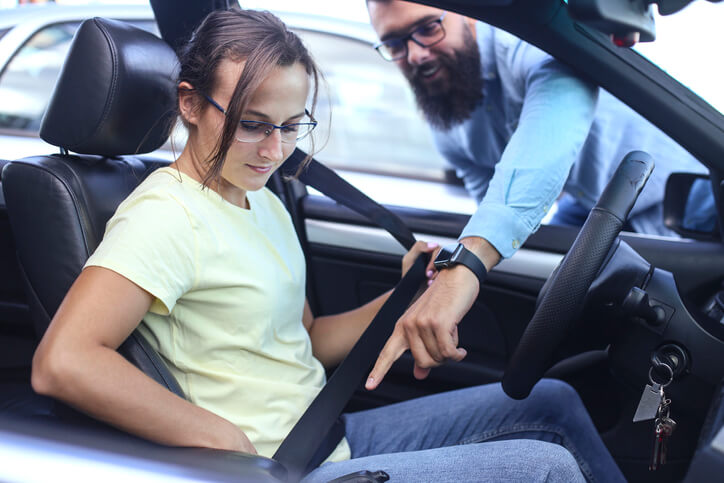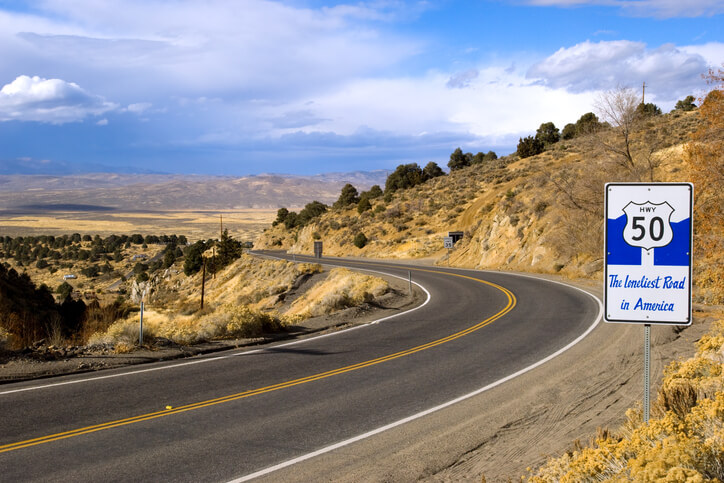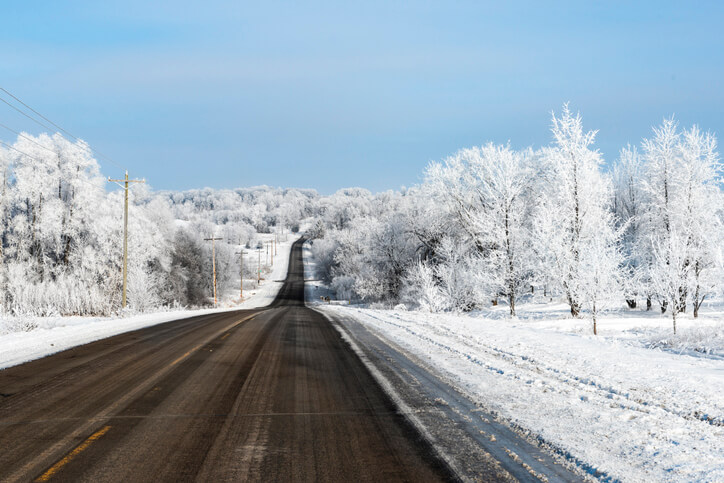Understanding New York state driving laws is crucial for anyone getting behind the wheel in the Empire State. This article cuts directly to the chase, providing you with the essential information on everything from speed limits and seat belt regulations to how to yield correctly, what to do at problematic intersections, and everything in between, ensuring you drive both legally and safely.
Whether you’re a longtime resident or just passing through, you’ll discover the ins and outs of navigating New York’s roads, dealing with traffic tickets, and keeping your driving privileges in good standing.
Key Takeaways
- New York State has variable speed limits based on the road type and conditions, strict right-of-way and seat belt laws, and consequences for violations, including fines, imprisonment, and points on a driving record.
- Driving in New York City requires knowledge of unique traffic laws, including parking regulations and tolls, and drivers must abstain from prohibited actions such as unnecessary honking and smoking in vehicles with minors.
- New York State employs a points system to track traffic violations, with penalties ranging from fines to license suspension. Drivers have the right to contest traffic tickets, and maintaining a valid license involves meeting initial requirements and following the renewal process.
Understanding New York State Traffic Laws
Traffic laws are not just rules; they are our guide to safety on the road. Given the hustle and bustle of New York, with its heavy traffic, bold pedestrians, and limited parking spaces, grasping traffic laws becomes all the more vital. Each region has specific traffic regulations, from the lively streets of New York City to the serene routes of Upstate New York.
Knowing these rules not only helps maintain a clean driving record but also plays a significant role in minimizing traffic violations and ensuring road safety.
Speed Limits and Regulations
Speed limits in New York State vary depending on the type of road and the location. For instance, the standard speed limit on state highways is 55 mph unless specific signs indicate otherwise. In contrast, suburban areas typically have a speed limit ranging from 25 to 30 mph, while school zones enforce a minimum speed limit of 15 mph. However, these limits are not rigid.
In fact, New York State law mandates drivers to adjust their speed according to prevailing weather and road conditions. Even if the posted speed limit on a city street is 45 mph, heavy snow or rain might necessitate slower speeds to ensure safety.
New York State’s Vehicle & Traffic Law defines the maximum speed limits for commercial vehicles, also establishing owner liability for non-compliance. A minimum speed limit, typically 45 mph, applies on New York State highways, irrespective of the time of day.
Right-of-Way Rules
Grasping right-of-way rules in New York State is critical for safe driving, particularly at intersections and driveways or when pedestrians are present. Here are some essential rules to remember:
- Drivers are required to adhere to any signage or signals at intersections.
- When making a left turn and encountering oncoming traffic, drivers must yield.
- Pedestrians always have the right of way at intersections.
The right-of-way rules also apply to emergency vehicles. When they are signaling and on duty, drivers must yield the right-of-way. It’s worth noting that failure to yield is considered a 3-point offense. However, emergency vehicle drivers must also exercise reasonable care for other road users. Failing to adhere to right-of-way rules can lead to:
- fines ranging from $150 to $500
- in certain instances, a maximum of 15 days of imprisonment
- in some cases, drivers may also be subject to a driver responsibility assessment.
Seat Belt and Child Safety Laws
In New York State, seat belt and child safety laws safeguard drivers and passengers across all age groups. These regulations hold importance as they aim to mitigate the chances of injury or fatality in the event of an accident. New York drivers must ensure that all passengers wear seat belts to avoid fines ranging from $50 for the driver to $25 to $100 for each passenger not wearing a seat belt.
Regarding child safety, children in New York State are required to use a car seat or booster seat until they reach approximately 10 to 12 years of age. From around four years old, children should transition from a car seat to a booster seat, with a supervising driver who’s 21 years old or older ensuring that children are using the appropriate restraint system. These laws are not only essential for protecting young passengers, but they also play a pivotal role in promoting responsible driving behaviors.
Navigating New York City Streets
They say New York City is the city that never sleeps. One thing is certain: NYC is a world unto itself when it comes to driving. With its bustling streets, towering skyscrapers, and a myriad of pedestrians and cyclists, driving in NYC is an experience like no other.
Understanding the city’s unique traffic laws, including parking regulations, tolls, and prohibited actions for New York City drivers, is key to safely and efficiently navigating its streets.
Parking Regulations in NYC
Parking in New York City can be quite challenging, and knowing the rules to avoid tickets is important. Here are some important rules to keep in mind:
- Double parking of passenger vehicles is prohibited at all times, even during street cleaning.
- Parking in front of a driveway is not permitted.
- Parking within 20 feet of a crosswalk at an intersection is not allowed.
- Parking within 30 feet of a traffic light is not permitted.
Make sure to follow these rules to avoid any parking violations.
Comprehending NYC’s street parking signs is vital for navigating the city’s intricate parking regulations. The NYC Department of Transportation posts numerous signs across the five boroughs to communicate the prevailing parking regulations. And remember, metered parking is free of charge from midnight to 7 am, so plan your trips accordingly.
Tolls in NYC
Getting around New York City often involves crossing bridges and tunnels, most of which require a toll. For example, the new congestion pricing plan will see vehicles entering Manhattan below 60th Street once per day are subject to a toll of up to $15, although the actual toll may vary, ranging from $9 to $23.
New York City offers several methods for paying tolls, including E-ZPass, Tolls by Mail, or Pay Toll Now. So, whether crossing the iconic Brooklyn Bridge or passing through the Lincoln Tunnel, make sure you’re prepared to pay the toll.
Prohibited Actions for NYC Drivers
Just as important as knowing what to do while driving in New York City is knowing what not to do. Certain actions are prohibited for drivers in the city, and violating these rules can result in penalties.
For instance, in NYC:
- Honking is only allowed in cases of emergency, and drivers may face fines for breaking this regulation.
- Smoking is prohibited in private passenger cars, vans, and trucks when a minor less than 14 years of age is a passenger.
- Smoking or vaping cannabis is also prohibited in private cars.
Dealing with Traffic Violations
Traffic violations, ranging from minor parking tickets to severe offenses like reckless driving, can pose serious issues for drivers in New York State. You need to understand the points system, have a working knowledge of associated fines and penalties, and know how to address a traffic ticket to avoid the worst results from traffic violations in New York.
Points System and Traffic Violations
The points system in New York State is a method used by the Department of Motor Vehicles (DMV) to track traffic violations and identify high-risk drivers. Traffic violations carry different point penalties; if you amass 11 points within an 18-month period, your license could be suspended.
For example, common traffic violations such as improper cell phone use, like texting while driving, carry 2 points. In contrast, more severe offenses, like reckless driving, will add 5 points to your license. Railroad crossing violations are also worth 5 points. It’s important to note that these points stay on your record for 18 months.
Fines and Penalties
Fines and penalties for traffic violations in New York State differ based on the specific violation. For instance, fines for speeding can range from $45 to $600, depending on the extent of the speed limit violation. Failure to maintain insurance may lead to fines ranging from $10 to $12 per day for lapses between 31 and 90 days, with potential penalties for a first offense exceeding $300.
Multiple traffic violations can lead to the following consequences, including a single traffic violation:
- Substantial fines
- Community service
- Suspension or revocation of their driver’s license
- Accumulation of points on their license
- Increased insurance premiums
- Imprisonment (in severe cases)
Contesting a Traffic Ticket
Receiving a traffic ticket doesn’t necessarily mean you have to accept it. You have the right to contest a traffic ticket if you believe you’ve been wrongly accused or if there are extenuating circumstances. To contest a traffic ticket in New York State, drivers can plead NOT GUILTY and follow the instructions on the ticket to complete the necessary paperwork and send it to the Court.
It’s important to note that individuals have 30 days from the date of the traffic ticket conviction to contest it. In addition, New York State allows drivers to challenge a traffic ticket online, making the process more convenient for those convicted at a Traffic Violations Bureau.
Driving Safely in New York State
Regardless of your mastery of traffic laws, safe driving ultimately hinges on the kind of safe driving awareness you can learn from the SPIDER Method and a comprehensive understanding of local driving laws. From defensive driving techniques to weather-related tips, sharing the road with pedestrians and cyclists, and navigating the known problematic intersections in roadways, there are plenty of ways to ensure a safe and pleasant driving experience in New York State.
Defensive Driving Techniques
Defensive driving techniques assist drivers in foreseeing and responding to potential dangers on the road, thus ensuring enhanced safety for themselves and others. The New York State Department of Motor Vehicles recommends critical defensive driving techniques such as:
- driving at a safe speed
- maintaining a safe following distance
- being aware of your surroundings
- anticipating potential hazards
- avoiding distractions while driving
Another crucial aspect of defensive driving is managing confrontational drivers. Here are some strategies for dealing with aggressive drivers on the road:
- Maintain composure
- Refrain from making eye contact
- Allow ample space
- Yield if needed
It’s important to practice defensive driving and abstain from participating in or exacerbating the situation.
Weather-Related Driving Tips
New York State experiences various weather conditions, which can impact driving. Different weather conditions require different driving techniques, from heavy rain and snow to fog and high winds. For instance, in heavy rain, it’s advisable to:
- Delay your trip until the weather improves
- Ensure your vehicle is in good condition and clean
- Use headlights for visibility
- Leave extra space between vehicles
- Slow down to prevent hydroplaning
- Avoid sharp turns or hard braking
When it comes to driving in icy or snowy conditions, here are some important safety measures to follow:
- Check the forecast before driving
- Ensure that your vehicle and headlights are free of snow or ice
- Reduce speed
- Increase following distance
- Avoid sudden stops and rapid acceleration
- Proceed cautiously on bridges, overpasses, and shaded areas
Following these measures will help ensure your safety on the road by maintaining your vehicle equipment properly.
Sharing the Road with Pedestrians and Cyclists
Sharing the road with pedestrians and cyclists is vital to safe driving in New York State. Both pedestrians and cyclists have the right to share the road, and drivers need to be aware of their presence and respect their rights. Recommended guidelines for safely operating a vehicle around pedestrians in New York State include:
- Utilizing sidewalks
- Implementing traffic calming measures to reduce speeding and aggressive driving
- Adhering to traffic control signals and signs
- Being mindful of common pedestrian hazards
- Yielding the right-of-way to pedestrians at crosswalks and intersections.
When it comes to cyclists, you should always:
- Consider the smaller size of cyclists
- Exercise caution regarding blind spots
- Acknowledge that bicyclists are required to adhere to traffic lights and signs, as well as signal for turns
It’s important for all drivers to respect the rights of pedestrians and cyclists and to remember that we all share the road.
Strategies for Specific Problematic Intersections in New York
Navigating New York’s intersections requires tailored strategies, especially in areas known for high-traffic incidents. At the notorious Times Square intersection, drivers should be exceptionally cautious of jaywalking pedestrians and frequently stopping taxis. The key is to drive slowly and prepare yourself for vehicles stopping suddenly ahead of you.
The Atlantic Avenue and Flatbush Avenue intersection in Brooklyn demands careful lane management due to its complex layout and heavy traffic flow. Choose your lane early, adhere to it, and avoid last-minute lane changes. The constant merging and diverging traffic near the Queensboro Bridge requires heightened awareness and a defensive driving approach. Using turn signals well in advance and maintaining a consistent speed can help you navigate safely. In these intersections, checking mirrors frequently for cyclists and motorbikes, often present in these dense areas, is vital for safety.
Specific Problematic Roadways in New York: Strategies for Safe Driving
Certain stretches of New York roadways require specific strategies for safe driving. On the Long Island Expressway, especially near exits and junctions, keeping a steady pace and avoiding aggressive lane changes can prevent collisions in this high-speed environment. For the FDR Drive, particularly during peak hours, drivers should anticipate frequent stop-and-go traffic and keep a safe distance from the vehicle ahead. In winter, roads like Route 17 in upstate New York can become slippery and treacherous. It’s crucial to have winter tires and drive at reduced speeds, especially in snowy or icy conditions. On the West Side Highway, where pedestrian crossings are frequent, drivers must be vigilant and ready to yield, ensuring safety for all road users. Employing these strategies tailored to specific road conditions and traffic patterns can significantly enhance driving safety in New York’s challenging roadways.
Obtaining and Maintaining a Valid Driver's License in New York State
A valid driver’s license paves the way to the open road. In New York State, procuring and maintaining that license entails a few crucial steps. From meeting the specific requirements to renewing on time and addressing any issues with your license, it’s important to keep your license in good standing to enjoy the freedom of driving in the Empire State.
NY License Requirements
You’ll need to meet specific license requirements to drive legally in New York State. First and foremost, you must be at least 16 years old. But that’s just the beginning. You’ll also need to pass a written permit test, correctly answering at least 14 out of 20 multiple-choice questions, including two correct responses related to road signs.
If you plan to ride a motorcycle, you must obtain a Class M or Class MJ driver’s license or learner permit. And if you’re a new resident in New York State, you’ll need to exchange your out-of-state license for a New York State driver’s license within 30 days of becoming a resident.
New York License Renewal Process
Maintaining your driver’s license validity is as crucial as obtaining it initially. In New York State, you must renew your driver’s license every 8 years. You can renew your license up to one year before it expires or 2 years after it has expired. Remember to celebrate your birthday by renewing your license. That’s when your license renewal is due.
Renewing your driver’s license isn’t just about your birthday, though – it also involves a fee. The cost to renew a standard Class D or DJ license ranges from $64.50 to $80.50, plus an additional Metropolitan Commuter Transportation District (MCTD) fee of $1 for every 6 months your license will be valid.
Addressing Issues with Your Driver's License
Despite meticulous planning, challenges may surface concerning your driver’s license. Whether it’s an error on your license or a suspension due to traffic violations, you’ll want to know how to address these issues. For instance, to rectify a driver’s license error in New York State, individuals can update their information with the DMV or address errors in their records.
If your license is suspended, you can seek authorization from the DMV Driver Improvement Unit and proceed with the application for license restoration. And if your address changes, you can update it via the online platform provided by the New York DMV website.
Out-of-State Drivers in New York
Suppose you’re an out-of-state driver intending to drive in New York. In that case, you should understand certain crucial information, including New York’s driving laws, license reciprocity agreements, and insurance requirements to keep your license in good standing and stay safe on your journey.
License Reciprocity
License reciprocity is a system where one state recognizes a driver’s license issued by another. This recognition allows out-of-state drivers to use their valid licenses in New York State for a limited time. However, as of February 1, 2023, New York has discontinued its reciprocal agreements with other states. These agreements mean out-of-state drivers should be mindful that their driving privileges from their home state are not automatically transferred, and they should take necessary measures to adhere to New York’s specific driving laws.
If you’re an international traveler and not a New York State resident, you’ll be pleased to know that New York State allows you to operate a vehicle with a valid driver’s license from another country.
Insurance Requirements
Just like residents of New York State, out-of-state drivers are also required to have New York State issued automobile liability insurance coverage. This coverage is necessary to drive lawfully in New York State.
Your car insurance policy from another state typically offers ‘out-of-state’ coverage, which is valid in all states, including New York. However, if you do not have sufficient car insurance coverage, you may face penalties such as:
- fines of up to $1,500
- suspension of driving privileges
- a $750 fee to reinstate a revoked license
- vehicle impoundment
- potential incarceration
Summary
Whether you’re a resident of New York State or an out-of-state visitor, understanding the state’s driving laws is crucial for a safe and enjoyable driving experience. From speed limits and right-of-way rules to parking regulations and dealing with traffic violations, these laws are designed to keep you and others safe on the road. By understanding and following these laws, you can ensure a smooth journey, whether navigating the bustling streets of New York City or exploring the picturesque roads of Upstate New York.
Frequently Asked Questions
What are the rules for driving in New York?
In New York, drivers must yield to other motorists or pedestrians to avoid accidents and yield to pedestrians in both marked and unmarked crosswalks. Additionally, drivers must stop for school buses with flashing lights or during loading and unloading.
Can a 17-year-old drive after 9 pm in NY State?
No, a 17-year-old with a junior license cannot drive after 9 pm in NY State unless they are driving directly from work or a school function.
Can you drive by yourself at 16 in NY?
No, you cannot drive by yourself at 16 in NY. Drivers aged 16-17 can apply for a Junior Drivers’ License, which may allow unsupervised driving in some parts of New York under the Graduated License Law.
What is the maximum speed limit in NY State?
The maximum speed limit in NY State is 65 mph. According to official regulations, it has been set at this limit since 1995.
What are the rules for a junior license in NY?
To obtain a junior driver’s license in New York, a 16-year-old must have had a learner’s permit for six months with no license suspension and submit a signed driving log with at least 50 hours of supervised driving, including 15 hours of night driving. Additionally, there are restrictions regarding driving hours and passengers once the junior license is obtained.



